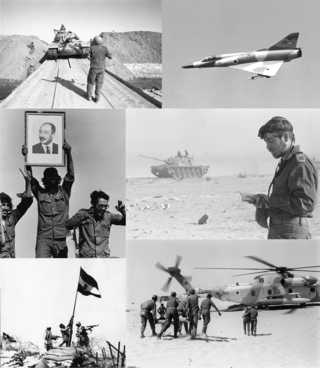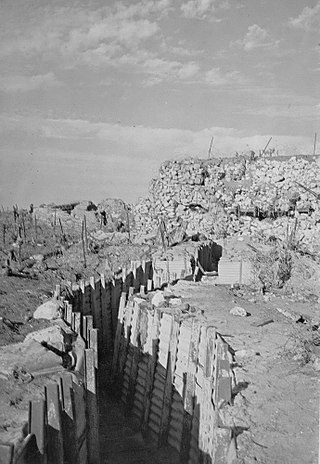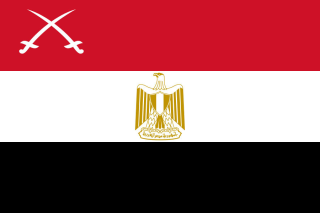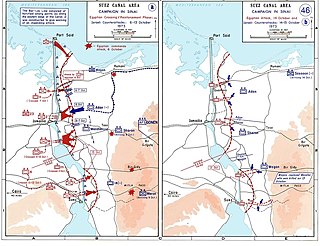
The Yom Kippur War, also known as the Ramadan War, the October War, the 1973 Arab–Israeli War, or the Fourth Arab–Israeli War, was fought from 6 to 25 October 1973 between Israel and a coalition of Arab states led by Egypt and Syria. Most of the fighting occurred in the Sinai Peninsula and Golan Heights, territories occupied by Israel in 1967. Some combat also took place in Egypt and northern Israel. Egypt aimed to secure a foothold on the eastern bank of the Suez Canal and use it to negotiate the return of the Sinai Peninsula.
The history of the Israel Defense Forces (IDF) intertwines in its early stages with history of the Haganah.

Operation Badr, also known as Plan Badr, was an Egyptian military offensive and operation across the Suez Canal that destroyed the Bar-Lev Line, a chain of Israeli fortifications along the frontline of the Israeli-occupied Sinai Peninsula, on 6 October 1973. It was launched in conjunction with a Syrian military offensive against the Israeli-occupied Golan Heights, triggering the Yom Kippur War. During the War of Attrition, which preceded Operation Badr, both Egypt and Syria had been seeking to recover the territories that Israel had captured from them during the 1967 Arab–Israeli War.

The 35th Paratroopers Brigade is an Israeli military airborne infantry brigade. It forms a major part of the Israeli Ground Forces' Infantry Corps, and has a history of carrying out special operations from the 1950s onwards. Soldiers of the brigade wear maroon berets with the Infantry Corps pin and russet boots.

The Bar-Lev Line was a chain of fortifications built by Israel along the eastern bank of the Suez Canal shortly after the 1967 Arab–Israeli War, during which Egypt lost the entire Sinai Peninsula. It was considered impenetrable by the Israeli military until it was overrun in less than two hours during Egypt's Operation Badr, which sparked the 1973 Arab–Israeli War.

Israel Tal, also known as Talik, was an Israel Defense Forces (IDF) general known for his knowledge of tank warfare and for leading the development of Israel's Merkava tank.

Avraham "Bren" Adan was an Israeli major-general and author. Prior to Israel's independence, he served with the Palmach, an elite formation within the Haganah paramilitary force of the Yishuv community in British Mandatory Palestine. Adan fought under the Haganah and later under the newly formed Israel Defense Forces during the First Arab–Israeli War, and was photographed while raising the Israeli Ink Flag at the site of what is now Eilat to mark the end of the war. He served with the Israel Defense Forces from 1948 to 1977, and fought in all of the major Arab–Israeli wars that occurred during that period.

Avraham Albert Mandler was an Israeli major general. His journey to then British Mandate of Palestine started from having been expelled at age 10 from his school in Linz, Austria before fleeing with his mother through multiple borders until reaching Romania and boarding the last illegal boat the British allowed to anchor in Haifa. At age 16 he joined the Haganah, at 19 he fought outside Jerusalem, and in subsequent wars he climbed the ranks until, as a Major-General fighting in Sinai till his death in the 1973 Yom Kippur War. In the 1967 Six-Day War he was a colonel commanding the 8th Mechanized Infantry Brigade. This brigade pushed "elements of the Shazli Force and the Egyptian 6th Division straight into an ambush laid by Arik Sharon" at Nakhl on June 8, 1967.

The Battle of the Chinese Farm took place during October 15 to October 17, 1973 between the Egyptian Army and the Israel Defense Forces (IDF), as part of the Yom Kippur War. It was fought in the Sinai Peninsula, north of the Great Bitter Lake and just east of the Suez Canal, near an Egyptian agricultural research station. The area was known to the Israeli military as the Chinese Farm – a misnomer resulting from the research station's use of Japanese-made equipment, with Japanese writing on the machinery mistaken by Israeli observers for Chinese characters.

The 2nd Mechanized Infantry Division of the Infantry Corps of the Egyptian Army is a heavy infantry formation created after the Second World War.

The Battle of the Sinai was one of the most consequential battles of the Yom Kippur war. An Egyptian attacking force that advanced beyond their line of defense at the Bar-Lev Line was repulsed with heavy losses by Israeli forces. This prompted the Israelis to launch Operation Abiray-Lev the next day, penetrating the Egyptian line of defense and crossing the Suez Canal.

The Battle of Suez was fought on October 24–25, 1973 between the Israel Defense Forces and the Egyptian Army in the Egyptian town of Suez. It was the closing battle of the Yom Kippur War, before a ceasefire took effect.
The Battle of 'Auja, also called Battle of Nitzana, was a military engagement between the Israel Defense Forces and the Egyptian Army in and around 'Auja, a small village on the Egypt–Israel border. It was fought on December 26–27, 1948, as part of Operation Horev, an Israeli campaign meant to expel all Egyptian forces from the country. The first stage of the operation was the simultaneous capture of 18 Egyptian positions on the Beersheba–'Auja road, including 7 around 'Auja.
Events in the year 1973 in Israel.

The Battle of Ismailia took place between the Egyptian Army and the Israeli Defense Forces (IDF) during the last stages of the Yom Kippur War during October 18–22, 1973, south of the city of Ismailia, on the west bank of the Suez Canal in Egypt. The battle itself took place as part of the larger IDF-launched Operation Abiray-Lev, in an attempt to seize Ismailia and thereby sever the logistical and supply lines of most of Egypt's Second Field Army across the Suez Canal.
The Romani Egyptian commando ambush was a battle waged on the morning of the second day of the Yom Kippur War, between the Egyptian military and the Israel Defense Forces in the northern section of the Sinai front, near the town of Romani. It was the Egyptians' most significant attempt to delay the arrival of the IDF's reserve forces at the front. It was also the first battle of the war in which IDF reserve forces took part and the first battle waged by the IDF's 162 Division.

The October 22 Scud missile attack, which took place in the midst of the 1973 Yom Kippur War, was the first operational use of Scud missiles in the world. It witnessed Egypt launch three Scud missiles against Israeli targets. One of the missiles was fired at Arish and the others at the Israeli bridgehead on the western bank of the Suez Canal, near Deversoir.

This article deals with the history and development of tanks of the Israeli Army, from their first use after World War II in the establishment of the State of Israel after the end of the British Mandate, and into the Cold War and what today is considered the modern era.

Amnon Reshef is a retired IDF major general who served as 14th Brigade Commander in the Yom Kippur War and as Commanding General of the Armored Corps from 1979 to 1982. In 2014 he founded Commanders for Israel's Security (CIS).

Operation Abirey-Halev or Operation Abirey-Lev also known as Operation Stouthearted Men and Operation Valiant, code-named Operation Gazelle, was an Israeli operation that took place in the center of the Suez Canal on 15–23 October 1973 during the Yom Kippur War.















